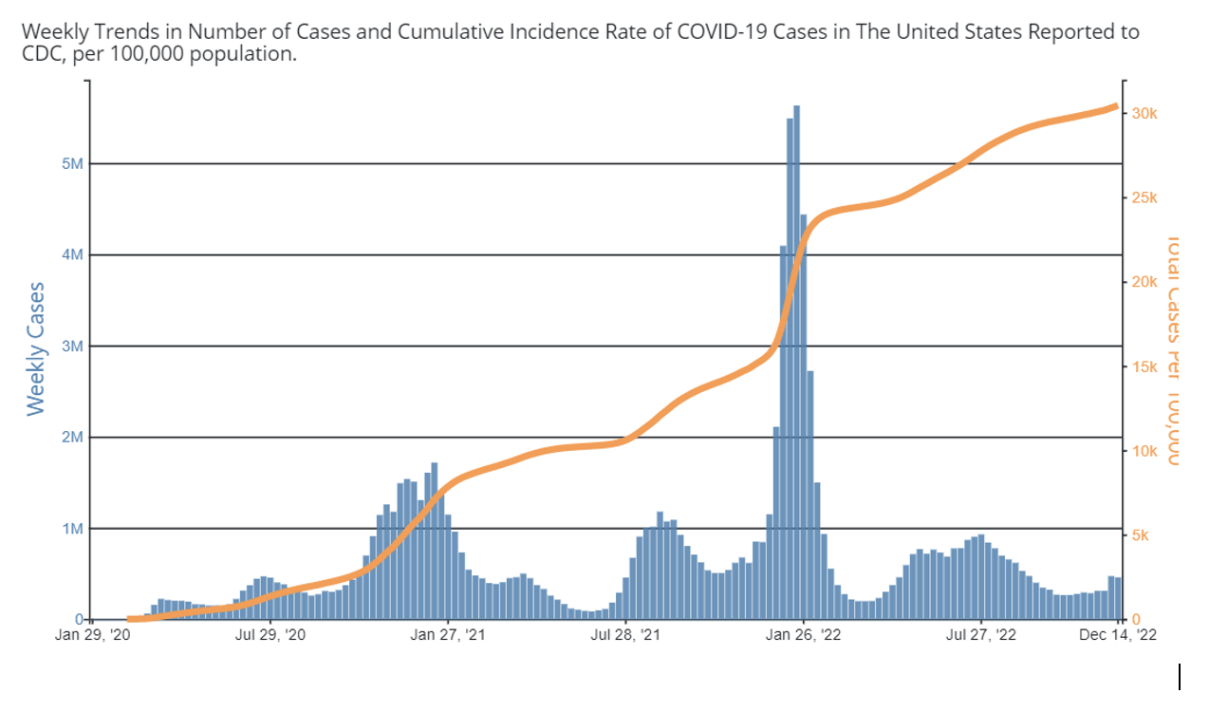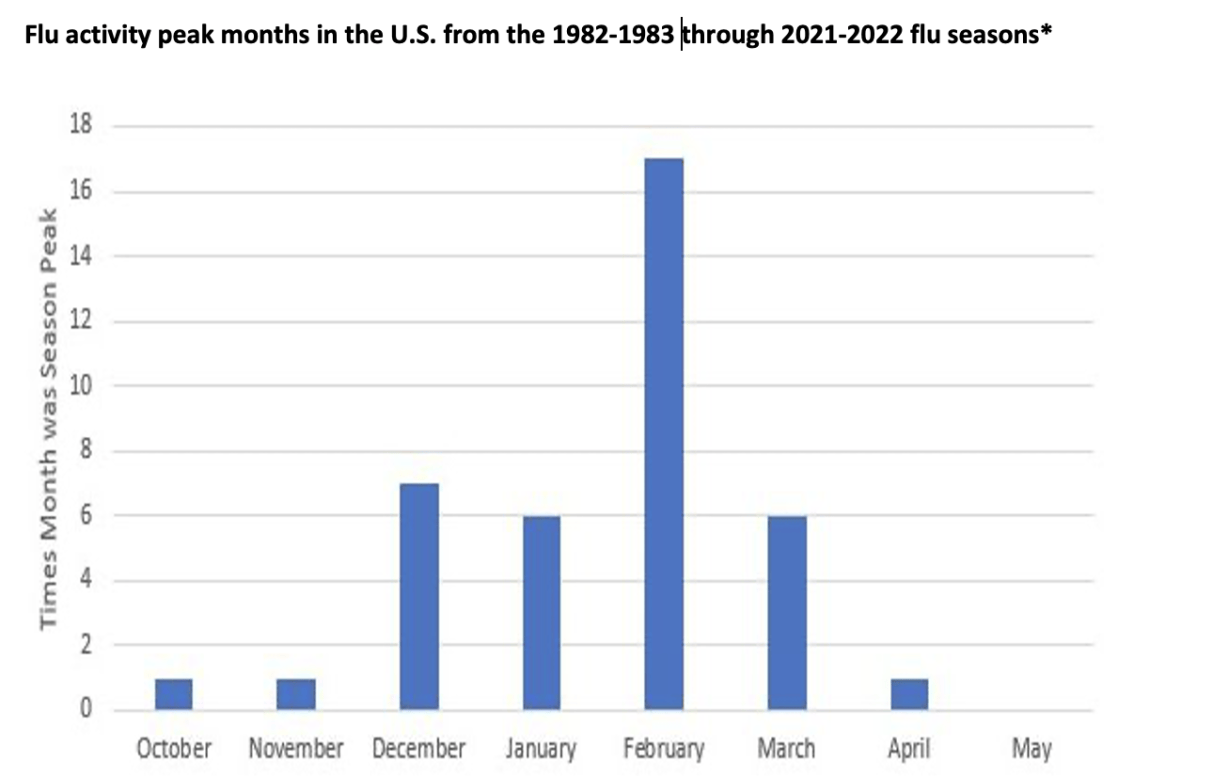
By Stephanie Spernak, contributor
A Virginia hospital leader warned that the area could be nearing another surge in COVID-19 cases, at a time when the flu and respiratory syncytial virus (RSV), have also been affecting residents at high rates.
Dr. Bogdan I. Neughebauer, vice president and chief medical officer at the hospital company Sentara Healthcare, told reporters Friday that the growing incidence of infections in Virginia is a “perfect trifecta” of viral diseases. He told reporters that data published Dec. 3 by the Virginia Department of Health showed that COVID-19 cases are at “very high” levels. Both COVID-19 cases and positive COVID-19 test results, a predictor of future case incidence, have shown recent increases.
“We may be at the beginning of another wave of COVID-19 infections,” said Neughebauer, who is also an infectious disease specialist.
Sentara Healthcare owns Sentara RMH Medical Center just east of Harrisonburg.
The most recent COVID-19 surveillance data for Dec. 9-15 — published Friday by the Virginia Department of Health — shows the increases in COVID-19 cases statewide and on the local level.

The COVID-19 data are consistent with previous COVID-19 wave patterns, Neughebauer said. Global data show significant upswings in COVID-19 cases at the beginning of the year, then decline through the spring and summer months. By fall, he said, COVID-19 cases begin to rapidly climb, reaching a peak in early January of the next year, before declining again.

He said COVID-19 data from Australia also suggest the United States could be in for another peak of COVID-19 infections. Australia, he said, has served as a useful harbinger of COVID-19 and other viral activity in the US because of its location in the southern hemisphere where weather patterns are opposite to those in the U.S.
Unlike the first two years of the COVID-19 pandemic, Neughebauer said a majority of COVID-19 patients have “mild to moderate” symptoms and do not need hospitalization. He also said there were far fewer COVID-19 patients admitted to intensive care units, and COVID-19 deaths have also declined significantly in the past six months.
At the start of the COVID pandemic in early 2020, “we didn’t know what it was, and we didn’t know how to treat it, but now we know,” he said.
Still, the confluence of spikes in cases of several different respiratory diseases could threaten the health care system.
In the past few weeks, the Centers for Disease Control (CDC) said that data have shown that if the number of infections continues to grow, the healthcare system will be stressed in terms of hospital capacity and staffing shortages.
CBS News reported that “as part of contingency plans for potential coronavirus surges this winter,” the Biden administration is offering free COVID-19 tests, available through covidtests.gov, to U.S. households.
Since the COVID-19 pandemic was officially proclaimed in March 2020, health care officials have been concerned about what might happen if COVID-19 and influenza infections converged at the same time.
Neughebauer said the CDC has reported 27 million flu cases so far for this season. However, 30 million people presented to their primary care physician or an emergency room with suspected flu. Of these, only 260,000 were admitted to the hospital for treatment, far less than 1% of the infected. There have been 21,000 flu deaths, a miniscule proportion of those infected with the flu virus.
In the United States, the flu season usually occurs in the fall and winter. While influenza viruses spread year-round, most of the time flu activity peaks between December and February, as shown in the graph below from the Centers of Disease Control (CDC). Between 9 million and 41 million Americans get the flu each year, according to the CDC. As many as 52,000 people may die from the flu.

Neughebauer said that flu activity was virtually absent during the 2020-2021 season, an anomaly that occurred as a result of social distancing, masking and lockdowns — the voluntary or mandated public health measures taken to reduce transmission of COVID-19 during the first year after the pandemic was officially declared in March 2020.
Epidemiologists speculated that these same public health measures, especially masking and social distancing would also stop the flu and other viruses like the RVS, as they are transmitted from person to person much the same way as the COVID-19 virus, although much effective at transmission than the COVID-19 virus.
The CDC has said that it is “likely that flu viruses and the virus that causes COVID-19 will both be spreading” this winter, although the agency said it could not be certain that this would happen.
The lack of exposure to the flu since March 2020 is likely to produce reduced immunity to other flu strains and is the reason there may be a severe flu season this year as people are again exposed to the flu virus. That’s exactly what happened in Australia, according to an August article in US News and World Report that reported Australia had just ended its worst flu season in five years.
But, a CNN story said that data published by the CDC on Dec. 16 showed that flu hospitalizations have decreased for the first time this season. The story said that the highest number of flu hospitalizations occurred during the week after Thanksgiving. But then CDC data showed that flu cases dropped by 10% the next week.
Neughebauer said this possible “plateauing” of flu infections may be a favorable development that could reduce the necessity of treating more than one viral infection in the same patient at the same time.
Nevertheless, the CDC warned that “flu activity remains high nationwide, and this is not a sign that flu has peaked. Like last week, all but seven states continue to have “high” or “very high” respiratory virus rates.
Reduced immunity could be a factor
RSV is the third virus currently circulating and producing infections. Neughebauer said that RSV has increased 10-fold in adults, something which has never been seen before. He said that RSV typically infects children not adults, and that most children have been infected by the time they are two years old.
Neughebauer said the increase in RSV cases this season among children is likely due to reduced immunity from lack of normal exposure because of the COVID-19 public health measures. The same phenomenon believed to account for increased flu infections, he said.
There is no treatment for RSV, but symptoms are typically mild in most cases over-the-counter remedies are effective in reducing them.
Neughebauer said that all three viral infections present with similar symptoms that include: dry cough,
fever, runny nose, shortness of breath, headache. But, he said, many who are infected show no symptoms at all. These features make accurate diagnosis of viral infection difficult.
Furthermore, the same risk factors are associated with severe symptoms and hospitalization for all three types of viral infections, Neughebauer said. These risk factors are age, (the very young and old), those with comorbidities such as heart disease and diabetes, patients taking immunosuppressive medications, and patients with immunosuppressive conditions.
Neughebauer gave the following general treatment recommendations based on viral symptoms. He said If symptoms are mild or moderate, the patient should stay home and treat them with over-the-counter medicines. If symptoms worsen, call your primary care physician, or go to an urgent care facility. And, If symptoms become severe and require immediate attention, call 911 or go to the nearest hospital emergency department.
Also winter …
Meanwhile, a new study by scientists at Massachusetts Eye and Ear Hospital and Northeastern University could shed new light on why certain illnesses spread in the winter.
The scientists discovered that after virus particles make their way into the body through the nose, by inhalation or touch, the cells in nasal cavities activate to expel those particles. But in colder temperatures, those nasal cells’ immune response is impaired.
Scientists found that a drop in temperature of just 5 degrees centigrade reduced the effectiveness of the nasal cells by almost half.
“To our knowledge, this study is the first to offer a biological explanation for why people are more likely to develop upper respiratory infections like cold, flu, and COVID-19 in colder temperatures,” the scientists wrote.
In the meantime, the scientists recommended hand washing and masking during cold weather to prevent viral particles from entering the nose.
Neughebauer, at the request of the Citizen, reviewed the study but declined to comment on its findings “without looking deeper into the research.”
With the approaching holidays when people will be gathering indoors, Neugebauer also advised hand washing, keeping distance from people who are coughing and sneezing, wearing a mask and keeping up with health-promoting behaviors — as well as enjoying time spent with family members and friends.
Journalism is changing, and that’s why The Citizen is here. We’re independent. We’re local. We pay our contributors, and the money you give goes directly to the reporting. No overhead. No printing costs. Just facts, stories and context. We’re also a proud member of the Virginia Press Association. Thanks for your support.












